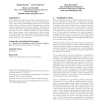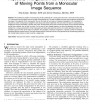101
Voted
ICRA
2010
IEEE
14 years 11 months ago
2010
IEEE
Abstract— Trajectory planning and optimization is a fundamental problem in articulated robotics. It is often viewed as a two phase problem of initial feasible path planning aroun...
111
Voted
GIS
2010
ACM
14 years 11 months ago
2010
ACM
With the prevalence of GPS-embedded mobile devices, enormous amounts of mobility data are being collected in the form of trajectory - a stream of (x,y,t) points. Such trajectories...
GIS
2010
ACM
14 years 11 months ago
2010
ACM
In this paper we address the problem of segmenting a trajectory such that each segment is in some sense homogeneous. We formally define different spatio-temporal criteria under ...
128
Voted
SAC
2008
ACM
15 years 1 days ago
2008
ACM
Because of the large amount of trajectory data produced by mobile devices, there is an increasing need for mechanisms to extract knowledge from this data. Most existing works have...
104
click to vote
PVLDB
2008
15 years 1 days ago
2008
Trajectory classification, i.e., model construction for predicting the class labels of moving objects based on their trajectories and other features, has many important, real-worl...
91
Voted
TSMC
2002
15 years 6 days ago
2002
A distributed robot control system is proposed based on a temporal self-organizing neural network, called competitive and temporal Hebbian (CTH) network. The CTH network can learn ...
PAMI
2000
15 years 10 days ago
2000
95
Voted
IJCV
2000
15 years 11 days ago
2000
We present a method for assessing the likelihoodof a trajectory of an object through a scene consisting of a number of other objects. The closest points on the trajectory to the o...
122
click to vote
AROBOTS
2002
15 years 13 days ago
2002
Abstract. To realize dynamically stable walking for a quadruped walking robot, the combination of the trajectory planning of the body and leg position (feedforward control) and the...
106
Voted
TROB
2008
15 years 14 days ago
2008
Sampling-based nonholonomic and kinodynamic planning iteratively constructs solutions with sampled controls. A constructed trajectory is returned as an acceptable solution if its &...





